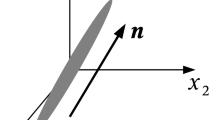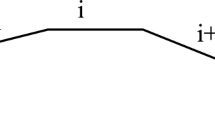Abstract
Numerical modelling of non-Newtonian flows usually involves the coupling between equations of motion characterized by an elliptic character, and the fluid constitutive equation, which defines an advection problem linked to the fluid history. There are different numerical techniques to treat the hyperbolic advection equations. In non-recirculating flows, Eulerian discretizations can give a convergent solution within a short computing time. However, the existence of steady recirculating flow areas induces additional difficulties. Actually, in these flows neither boundary conditions nor initial conditions are known. In this paper we compares different advanced strategies (some of them recently proposed and extended here for addressing complex flows) when they are applied to the solution of the kinetic theory description of a short fiber suspension fluid flows.
Similar content being viewed by others
References
Achdou Y, Pironneau O (2005) Computational methods for option pricing. SIAM, Philadelphia
Advani SG, Tucker III ChL (1990) Closure approximations for three-dimensional structure tensors. J Rheol 34:367–386
Ammar A, Chinesta F (2005) A particle strategy for solving the Fokker-Planck equation governing the fiber orientation distribution in steady recirculating flows involving short fiber suspensions. Lect Notes Comput Sci Eng 43:1–16
Ammar A, Ryckelynck D, Chinesta F, Keunings R (2006) On the reduction of kinetic theory models related to finitely extensible dumbbells. J Non-Newton Fluid Mech 134:136–147
Ammar A, Mokdad B, Chinesta F, Keunings R (2006) A new family of solvers for some classes of multidimensional partial differential equations encountered in kinetic theory modeling of complex fluids. J Non-Newton Fluid Mech 139:153–176
Ammar A, Mokdad B, Chinesta F, Keunings R (2007) A new family of solvers for some classes of multidimensional partial differential equations encountered in kinetic theory modeling of complex fluids. Part II: Transient simulation using space-time separated representation. J Non-Newton Fluid Mech 144:98–121
Azaiez J, Chiba K, Chinesta F, Poitou A (2002) State-of-the-Art on numerical simulation of fiber-reinforced thermoplastic forming processes. Arch Comput Methods Eng 9(2):141–198
Ballenger TF, White JL (1971) Flow patterns in polymer melts in the reservoir of a capillary rheometer. Chem Eng Sci 25:1191
Bialecki RA, Kassab AJ, Fic A (2005) Proper orthogonal decomposition and modal analysis for acceleration of transient FEM thermal analysis. Int J Numer Meth Eng 62:774–797
Binding DM (1988) An approximate analysis for contraction and converging flows. J Non-Newton Fluid Mech 27:173
Boger DV (1987) Viscoelastic flows through contractions. Annu Rev Fluid Mech 19:157
Bungartz HJ, Griebel M (2004) Sparse grids. Acta Numer 13:1–123
Burkardt J, Gunzburger M, Lee H-Ch (2006) POD and CVT-based reduced-order modeling of Navier-Stokes flows. Comput Methods Appl Mech Eng 196:337–355
Chaidron G, Chinesta F (2001) On the periodicity of the extra-stress tensor in steady recirculating viscoelastic flows. In: Proceedings of the first MIT conference on computational fluid and solid mechanics. MIT Press, Cambridge
Chaubal CV, Srinivasan A, Egecioglu O, Leal LG (1997) Smoothed particle hydrodynamics techniques for the solution of kinetic theory problems. J Non-Newton Fluid Mech 70:125–154
Chauviere C, Lozinski A (2004) Simulation of dilute polymer solutions using a Fokker-Planck equation. Comput Fluids 33:687–696
Chinesta F, Chaidron G (2001) On the steady solution of linear advection problems in steady recirculating flows. J Non-Newton Fluid Mech 98:65–80
Chinesta F, Chaidron G, Poitou A (2003) On the solution of the Fokker-Planck equation in steady recirculating flows involving short fiber suspensions. J Non-Newton Fluid Mech 113:97–125
Cogswell FN (1973) Converging flow of polymer melts in extrusion dies. Polym Eng Sci 12:64
Dennison MT (1967) Flow instability in polymer melts: a review. Plast Inst Trans 35:803
Dodson AG, Townsend P, Walters K (1974) Non-Newtonian flow in pipes of non-circular cross-section. Comput Fluids 2:317
Dupret F, Verleye V (1999) Modelling the flow of fiber suspensions in narrows gaps. In: Siginer DA, De Kee D, Chabra RP (eds) Advances in the flow and rheology of non-Newtonian fluids. Rheology series. Elsevier, Amsterdam, pp 1347–1398
Giesekus H (1966) Zur Stabilität von Strömungen viskoelastischer Flüssigkeiten. Rheol Acta 5:239
Giesekus H (1969) Verschiedene Phänomene in Strömungen viskoelastischer Flüssigkeiten durch Düsen. Rheol Acta 8:411
Gunzburger MD, Peterson JS, Shadid JN (2007) Reduced-order modeling of time-dependent PDEs with multiple parameters in the boundary data. Comput Methods Appl Mech Eng 196:1030–1047
Jendrejack R, de Pablo J, Graham M (2002) A method for multiscale simulation of flowing complex fluids. J Non-Newton Fluid Mech 108:123–142
Keunings R (2004) Micro-macro methods for the multiscale simulation viscoelastic flow using molecular models of kinetic theory. In: Binding DM, Walters K (eds) Rheology reviews. British Society of Rheology, UK, pp 67–98
Kim-E ME, Brown RA, Armstrong RC (1983) The roles of inertia and shear-thinning in flow of an inelastic liquid through an axisymmetric sudden contraction. J Non-Newton Fluid Mech 13:341
Lipscomb II GG, Denn MM, Hur DH, Boger DH (1988) The flow of fiber suspensions in complex geometries. J Non-Newton Fluid Mech 26:297–325
Lozinski A, Chauviere C (2003) A fast solver for Fokker-Planck equation applied to viscoelastic flows calculations: 2D FENE model. J Comput Phys 189:607–625
Maday Y, Ronquist EM (2004) The reduced basis element method: application to a thermal fin problem. SIAM J Sci Comput 26(1):240–258
Manhart M (2003) Rheology of suspensions of rigid-rod like particles in turbulent channel flow. J Non-Newton Fluid Mech 12:269–293
Muller SJ, Larson RG, Shaqfeh ESG (1999) A purely elastic transition in Taylor-Couette flow. Rheol Acta 28:499
Oldroyd JG (1965) Some steady flows of the general elastic-viscous liquid. Proc R Soc Lond A 283:115
Öttinger HC, Laso M (1992) Smart polymers in finite element calculation. In: int Congr on rheology. Brussels, Belgium
Park HM, Cho DH (1996) The use of the Karhunen-Loève decomposition for the modelling of distributed parameter systems. Chem Eng Sci 51:81–98
Petrie CJS, Denn MM (1976) Instabilities in polymer processing. AIChE J 22(2):209
Pruliere E, Ammar A, Chinesta F (2007) Empirical natural closure relation for short fiber suspension models. Int J Form Process 10(3):361–385
Ryckelynck D (2005) A priori hyper-reduction method: an adaptive approach. J Comput Phys 202:346–366
Ryckelynck D, Hermanns L, Chinesta F, Alarcón E (2005) An efficient “a priori” model reduction for boundary element models. Eng Anal Bound Elem 29:796–801
Ryckelynck D, Chinesta F, Cueto E, Ammar A (2006) On the a priori model reduction: overview and recent developments. Arch Comput Methods Eng 13(1):91–128
Somasi M, Khomami B, Woo NJ, Hur JS, Shaqfeh ESG (2002) Brownian dynamics simulations of bead-rod and bead-spring chains: numerical algorithms and coarse-graining issues. J Non-Newton Fluid Mech 108(1–3):227–255
Taylor GI (1923) Stability of a viscous liquid contained between two rotating cylinders. Philos Trans R Soc Lond A 223:289
Venkiteswaran G, Junk M (2005) A QMC approach for high dimensional Fokker-Planck equations modelling polymeric liquids. Math Comput Simul 68:43–56
Xue SC, Phan-Thien N, Tanner RI (1885) Numerical study of secondary flows of viscoelastic fluid in straight pipes by an implicit finite volume method. J Non-Newton Fluid Mech 59:191
Author information
Authors and Affiliations
Corresponding author
Rights and permissions
About this article
Cite this article
Pruliere, E., Ammar, A., El Kissi, N. et al. Recirculating Flows Involving Short Fiber Suspensions: Numerical Difficulties and Efficient Advanced Micro-Macro Solvers. Arch Computat Methods Eng 16, 1–30 (2009). https://doi.org/10.1007/s11831-008-9027-9
Received:
Accepted:
Published:
Issue Date:
DOI: https://doi.org/10.1007/s11831-008-9027-9




